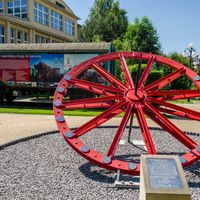Cholerzyn Depression
6.5

Overview
The Cholerzyńskie Depression is a physiographic mesoregion located in southern Poland, in the northwestern part of the Kraków Gate. It borders various geographical formations such as the Tenczynek Ridge, the Krzeszowice Graben, the Olkusz Upland, the Proszowice Plateau, the Kraków Threshold, the Skawina Graben, and the Upper Vistula Valley. This region is characterized by a tectonic depression, primarily composed of Miocene clays covered with loess, among other deposits. The terrain elevation ranges from 40 to 50 meters above the Vistula River valley floor, giving it a flat, plain-like character.
The depression occupies part of the northwestern districts of Kraków, making it a significant element of the city's urban landscape. Historically, the area has been inhabited since ancient times, which is reflected in local traditions, architecture, and culture. The architectural character of the region is diverse, with a predominance of traditional buildings that reflect local styles and history.
Cholerzyńskie is also a place rich in culture, with numerous local events, festivals, and traditions that attract both residents and tourists. All aspects related to the cultural life of the local community are part of the broader cultural context of Kraków, one of Poland's most important cultural centers.
Interestingly, the name of the depression comes from the village of Cholerzyn, which is located within this region. Additionally, the geography of the area is conducive to recreation and tourism, making it an attractive destination for both locals and tourists seeking to explore the unique natural and cultural values of this part of Poland. With its picturesque landscapes, valuable geological resources, and rich history, the Cholerzyńskie Depression is a fascinating feature in the physiographic and cultural landscape of the Lesser Poland region.
Location
Tickets
Powered by GetYourGuide
You can also find here:

Białoprądnicki Manor Cultural Center
8.16
District IV Prądnik Biały, Cracow

District VII Zwierzyniec
8.07
Cracow

Błonia
7.55
District VII Zwierzyniec, Cracow

Stanisław Staszic University of Science and Technology in Krakow
6.94
District V Krowodrza, Cracow

Zielonki
6.93
Bolechowice Deanery

District V Krowodrza
6.92
Cracow

AGH Locomotive
6.83
District V Krowodrza, Cracow

Historical Museum of the City of Kraków
6.81
District V Krowodrza, Cracow

Marek Grechuta Krakowski Park
6.78
District V Krowodrza, Cracow

District IV Prądnik Biały
6.75
Cracow
2025 Wizytor | All Rights Reserved